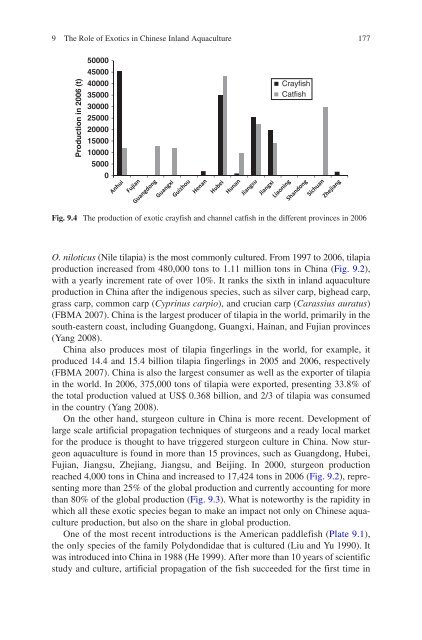Success Stories In Asian Aquaculture - Library - Network of ...
Success Stories In Asian Aquaculture - Library - Network of ...
Success Stories In Asian Aquaculture - Library - Network of ...
- No tags were found...
Create successful ePaper yourself
Turn your PDF publications into a flip-book with our unique Google optimized e-Paper software.
9 The Role <strong>of</strong> Exotics in Chinese <strong>In</strong>land <strong>Aquaculture</strong>177Production in 2006 (t)50000450004000035000300002500020000150001000050000CrayfishCatfishFig. 9.4 The production <strong>of</strong> exotic crayfish and channel catfish in the different provinces in 2006O. niloticus (Nile tilapia) is the most commonly cultured. From 1997 to 2006, tilapiaproduction increased from 480,000 tons to 1.11 million tons in China (Fig. 9.2 ),with a yearly increment rate <strong>of</strong> over 10%. It ranks the sixth in inland aquacultureproduction in China after the indigenous species, such as silver carp, bighead carp,grass carp, common carp ( Cyprinus carpio ), and crucian carp ( Carassius auratus )(FBMA 2007) . China is the largest producer <strong>of</strong> tilapia in the world, primarily in thesouth-eastern coast, including Guangdong, Guangxi, Hainan, and Fujian provinces(Yang 2008) .China also produces most <strong>of</strong> tilapia fingerlings in the world, for example, itproduced 14.4 and 15.4 billion tilapia fingerlings in 2005 and 2006, respectively(FBMA 2007) . China is also the largest consumer as well as the exporter <strong>of</strong> tilapiain the world. <strong>In</strong> 2006, 375,000 tons <strong>of</strong> tilapia were exported, presenting 33.8% <strong>of</strong>the total production valued at US$ 0.368 billion, and 2/3 <strong>of</strong> tilapia was consumedin the country (Yang 2008) .On the other hand, sturgeon culture in China is more recent. Development <strong>of</strong>large scale artificial propagation techniques <strong>of</strong> sturgeons and a ready local marketfor the produce is thought to have triggered sturgeon culture in China. Now sturgeonaquaculture is found in more than 15 provinces, such as Guangdong, Hubei,Fujian, Jiangsu, Zhejiang, Jiangsu, and Beijing. <strong>In</strong> 2000, sturgeon productionreached 4,000 tons in China and increased to 17,424 tons in 2006 (Fig. 9.2 ), representingmore than 25% <strong>of</strong> the global production and currently accounting for morethan 80% <strong>of</strong> the global production (Fig. 9.3 ). What is noteworthy is the rapidity inwhich all these exotic species began to make an impact not only on Chinese aquacultureproduction, but also on the share in global production.One <strong>of</strong> the most recent introductions is the American paddlefish (Plate 9.1),the only species <strong>of</strong> the family Polydondidae that is cultured (Liu and Yu 1990) . Itwas introduced into China in 1988 (He 1999) . After more than 10 years <strong>of</strong> scientificstudy and culture, artificial propagation <strong>of</strong> the fish succeeded for the first time in
















